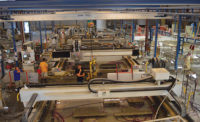Shortly after that, the U.S. Green Building Council (USGBC) held its 10th annual Greenbuild Conference in Toronto, Canada. Similarly, from this conference I was interested in learning how the trend is holding up in North America, especially in light of the current economic malaise and the challenging regulatory and political climate. The level of activity and the momentum behind this movement is easy to ignore if you are not involved, engaging with others in the industry or otherwise paying close attention. I am but a voice of one, but I thought I would share what I see in the hopes that it may inspire others to take a closer look at these important forces that will impact our success in the years to come:
1. Attendance at the Natural Stone Council (NSC) sustainability meeting in Verona was disappointing; however, generally speaking, stone companies in other parts of the world are embracing the sustainability trend in much greater numbers. They recognize that it is more than a marketing exercise to achieve a label that might result in more products sold. The European Environmental Product Declaration (EPD) system is gaining in legitimacy and acceptance. As a system, it is moving beyond products alone to address company issues. As a result, foreign stone companies are generally more progressive than most domestic companies. With a history of early adoption of change and innovation, they are once again demonstrating this in their approach to sustainability.
2. Product manufacturers and the associations representing materials that compete directly with natural stone are spending millions in an effort to influence the criteria used by the construction industry to evaluate products. Once established, millions more are being spent to position their companies and products in the best possible light as green building product criteria are adopted.
3. The building industry itself -- its owners and developers, architects, designers and contractors -- recognize the challenges of implementing green standards. At the same time, they are committed to breaking through the barriers to get it done, and decisions are being made today that will be implemented in the next several years. Building codes will include specific sustainability performance requirements impacting projects, the products involved and the companies providing them.
4. By policy, governments -- both domestic and overseas -- are embracing the idea that energy, water, chemicals, dust, etc. are significant global issues. Some of the concerns are supply-and-demand related, while others are more closely associated with medium- and long-term environmental and human health issues. They all have an economic component that is significant for the construction industry, and there is resolve to make sure these concerns are addressed.
5. Economics will ultimately drive the implementation of sustainability as an emerging megatrend. There is an excellent article titled "The Sustainability Imperative" in the May 2010 Harvard Business Review that I consider a "must read." It highlights this trend, makes a strong case for how megatrends happen, and provides insight into the companies that excel during periods of significant change and how they think about leading their companies through them.
6. Those with the vision and the resolve to challenge the status quo and execute on that vision will benefit from the fundamental change that is taking place. There is some risk involved, but the risk of complacency and/or denial is far greater in my estimation.
There is activity taking place in our industry on this front. In fact, there has been for quite some time. The NSC is leading an effort to establish a standards and certification process for natural stone on behalf of the natural stone industry. It is a significant effort and worthy of our support. It has been well publicized by many of the stone associations and written about many times in this publication. However, I have seen recent communications that suggest some in the industry feel left out and uninformed. I can only repeat what I stated earlier. What is happening is easy to ignore if you are not involved and engaged with others in the industry and paying close attention.
I continue to believe there is real value in proactively positioning the stone industry within the sustainability arena. If that turns out to be too lofty a goal, I believe we will all suffer if we don't at the very least come together in an attempt to level the playing field relative to competing materials. Of course, with or without an industry standard, any company can choose to move down a sustainable path, and all companies should. But there is strength in numbers, and we are up against significant competitive forces. It would be a shame to see the extraordinary efforts of those who would devote the time and effort to improving the whole laid waste because it is easier to convince ourselves that "stone is natural, therefore it is sustainable" and we need do nothing.
Progress is hard. Fear and anxiety are a part of taking a step into uncharted territory; however progress is made only when we are willing to take that step. I can only hope we have the courage to follow those who have a vision for tomorrow and are not afraid to achieve it.
Stone companies in other parts of the world are embracing the sustainability trend in much greater numbers. They recognize that it is more than a marketing exercise to achieve a label that might result in more products sold.
Product manufacturers and the associations representing materials that compete directly with natural stone are spending millions in an effort to influence the criteria used by the construction industry to evaluate products.
Economics will ultimately drive the implementation of sustainability as an emerging megatrend.
What is happening is easy to ignore if you are not involved and engaged with others in the industry and paying close attention.

